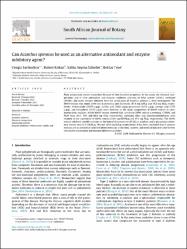| dc.contributor.author | Sarıkürkçü, Cengiz | |
| dc.contributor.author | Kırkan, Bülent | |
| dc.contributor.author | Şahinler, Saliha Şeyma | |
| dc.contributor.author | Tepe, Bektaş | |
| dc.date.accessioned | 2022-06-09T13:37:41Z | |
| dc.date.available | 2022-06-09T13:37:41Z | |
| dc.date.issued | 2022 | en_US |
| dc.identifier.citation | Sarikurkcu, C., Kirkan, B., Sahinler, S. S., & Tepe, B. (2022). Can Acanthus spinosus be used as an alternative antioxidant and enzyme inhibitory agent?. South African Journal of Botany, 145, 135-141. | en_US |
| dc.identifier.issn | 0254-6299 | |
| dc.identifier.uri | https://doi.org/10.1016/j.sajb.2021.11.006 | |
| dc.identifier.uri | https://hdl.handle.net/20.500.12933/1148 | |
| dc.description.abstract | Plant polyphenols attract researchers because of their bioactive properties. In this study, the chemical compositions and in vitro antioxidant and enzyme inhibitory activities of ethyl acetate (EtOAc), methanol (MeOH), and water extracts obtained from the aerial parts of Acanthus spinosus L. were investigated. The MeOH extract was found to be rich in phenolics and flavonoids (47.4 mg GAE/g and 19.2 mg RE/g, respectively). Verbascoside (28979 μg/g), vanillic acid (4342 μg/g), pinoresinol (3211 μg/g), syringic acid (1272 μg/g), and kaempferol (1170 μg/g) were detected as the main components of MeOH extract in chromatographic analyzes. While MeOH extract showed high activity in DPPH radical scavenging, CUPRAC and FRAP tests (44.1, 106, and 60.8 mg TE/g, respectively), chelating effect and phosphomolybdenum tests resulted in the superiority of EtOAc extract (18.6 mg EDTAE/g and 473 mg TE/g, respectively). The EtOAc extract exhibited notable activities in the butyrylcholinesterase (BChE), α-amylase, and α glucosidase inhibitory activity tests (1.9 GALAE/g, 785 and 1658 mg ACE/g, respectively). It has been concluded that A. spinosus extracts are an alternative source of phytochemicals in the food, cosmetic and medical industries due to their remarkable antioxidant and enzyme inhibitory activities. | en_US |
| dc.language.iso | eng | en_US |
| dc.publisher | Elsevier | en_US |
| dc.relation.isversionof | 10.1016/j.sajb.2021.11.006 | en_US |
| dc.rights | info:eu-repo/semantics/embargoedAccess | en_US |
| dc.subject | Acanthus spinosus | en_US |
| dc.subject | Chemical composition | en_US |
| dc.subject | Antioxidant activity | en_US |
| dc.subject | Enzyme inhibition | en_US |
| dc.subject | Verbascoside | en_US |
| dc.subject | Vanillic acid | en_US |
| dc.title | Can Acanthus spinosus be used as an alternative antioxidant and enzyme inhibitory agent? | en_US |
| dc.type | article | en_US |
| dc.authorid | 0000-0001-5094-2520 | en_US |
| dc.authorid | 0000-0003-4370-1686 | en_US |
| dc.department | AFSÜ, Eczacılık Fakültesi, Temel Eczacılık Bilimleri Bölümü | en_US |
| dc.contributor.institutionauthor | Sarıkürkçü, Cengiz | |
| dc.contributor.institutionauthor | Şahinler, Saliha Şeyma | |
| dc.identifier.volume | 145 | en_US |
| dc.identifier.startpage | 135 | en_US |
| dc.identifier.endpage | 141 | en_US |
| dc.relation.journal | South African Journal of Botany | en_US |
| dc.relation.publicationcategory | Makale - Uluslararası Hakemli Dergi - Kurum Öğretim Elemanı | en_US |
















